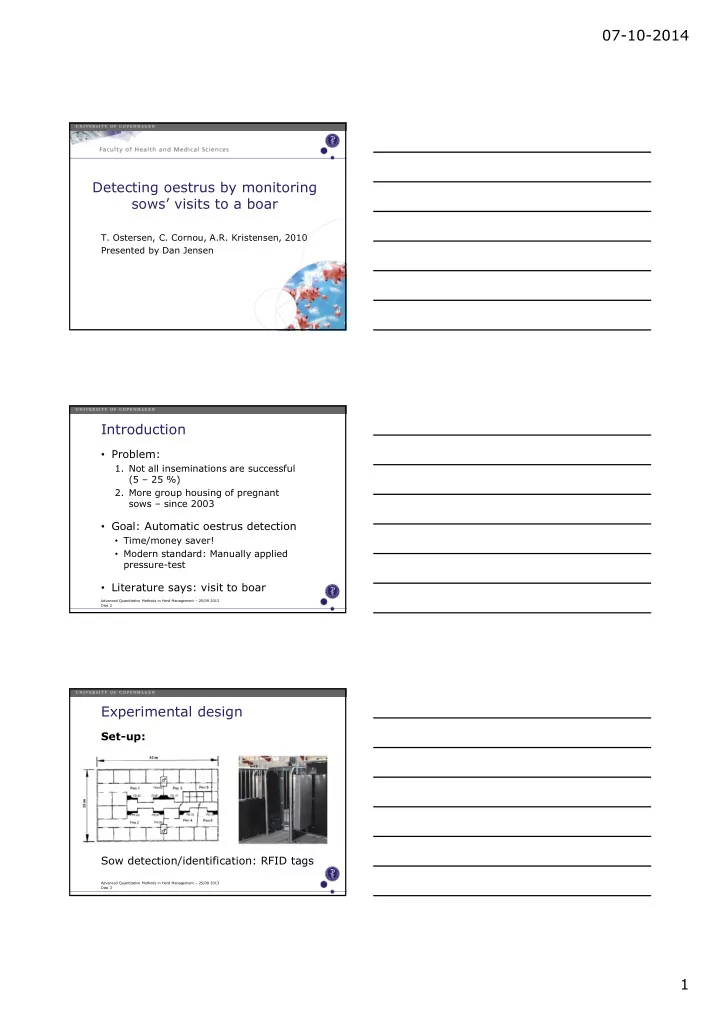

07-10-2014 Detecting oestrus by monitoring sows’ visits to a boar T. Ostersen, C. Cornou, A.R. Kristensen, 2010 Presented by Dan Jensen Introduction • Problem: 1. Not all inseminations are successful (5 – 25 %) 2. More group housing of pregnant sows – since 2003 • Goal: Automatic oestrus detection • Time/money saver! • Modern standard: Manually applied pressure-test • Literature says: visit to boar Advanced Quantitative Methods in Herd Management – 25/09 2013 Dias 2 Experimental design Set-up: Sow detection/identification: RFID tags Advanced Quantitative Methods in Herd Management – 25/09 2013 Dias 3 1
07-10-2014 Experimental design Learning data: • 41 sows in controlled environments, all in post-weaning oestrus: 1. 5 sows, 2005 2. 12 sows, 2007 3. 24 sows, 2008 17 were inseminated, 24 were not • Back pressure test 3 times/day • Continuous measure of boar visits • Advanced Quantitative Methods in Herd Management – 25/09 2013 Dias 4 Experimental design Test data: Collected: October 2004 – June 2009 • 3886 test periods (>= 14 days) • 111 cases of gestation oestrus • Advanced Quantitative Methods in Herd Management – 25/09 2013 Dias 5 Quick data structure overview From this, models must account for: 1. Individual patterns 2. Outliers 3. Diurnal effect Advanced Quantitative Methods in Herd Management – 25/09 2013 Dias 6 2
07-10-2014 Indicator 1: Visit duration Dynamic linear model (DLM): Observation equation System equation Y t = log(seconds/visit) Error terms, v t and w t , are considered independant and normally distributed Advanced Quantitative Methods in Herd Management – 25/09 2013 Dias 7 Indicator 1: Visit duration Four states – four sets of DLM: State change determined by: Observation • Markov Prior • probability Multi process, class 2 • Normal model estimated for each sow Advanced Quantitative Methods in Herd Management – 25/09 2013 Dias 8 Indicator 1: Visit duration Factors optimized in Learning data: Prior probabilities ( ) • Time threshold ( ∆ ) • Prior point estimate • of variance ( S0 ) Method: Maximize oestrus SE and SP • per 24 hours (-72 h to +48 h) Alarm if p(Oestrus) > 0.8 • Advanced Quantitative Methods in Herd Management – 25/09 2013 Dias 9 3
07-10-2014 Indicator 1: Visit duration Optimization results Per day! SE = 0.96 per pig! Advanced Quantitative Methods in Herd Management – 25/09 2013 Dias 10 5 minute break Advanced Quantitative Methods in Herd Management – 25/09 2013 Dias 11 Indicator 2: Visit frequency Low High Low Advanced Quantitative Methods in Herd Management – 25/09 2013 Dias 12 4
07-10-2014 Indicator 2: Visit frequency Data is Poisson distributed: - Dynamic Generalised Linear Model! Probability function Y t = N visits / 6 hrs Compromise – variability vs. W = system variance responstime Advanced Quantitative Methods in Herd Management – 25/09 2013 Dias 13 Indicator 2: Visit frequency Parameter estimation, using learning data: Method: Minimize squared forecast errors during normal conditions Result: Advanced Quantitative Methods in Herd Management – 25/09 2013 Dias 14 Indicator 2: Visit frequency The point: we can make a forecast! Optimized limit: OI > 3.3 Advanced Quantitative Methods in Herd Management – 25/09 2013 Dias 15 5
07-10-2014 A combined model The two models are combined using Bayes theorem: P(oestrus) = result of duration model P(+|oestrus) = sensitivity of duration model P(-|oestrus) = 1-sensitivity of duration model Threshold: 0.95 Advanced Quantitative Methods in Herd Management – 25/09 2013 Dias 16 Results (LR = Likelihood Ratio) Advanced Quantitative Methods in Herd Management – 25/09 2013 Dias 17 Conclusions, 1 Best detection model: 1. Duration by the boar Model is good (better) for: 1. Oestrus detection in gestation station! Advanced Quantitative Methods in Herd Management – 25/09 2013 Dias 18 6
07-10-2014 Conclusions, 2 Advances over others: 1. Better specificity 2. Better response time (1 – 6 hours vs. 1 day) Shortcomings(?): 1. Lower sensitivity ( e . g. 93 % by Bressers et al. ) Improvement perspectives: 1. Include more information: 1. Feeding rank 2. Activity 3. Pregnancy test Advanced Quantitative Methods in Herd Management – 25/09 2013 Dias 19 7
Recommend
More recommend